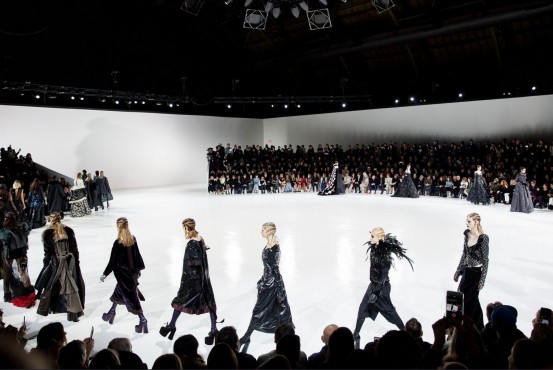Take everything you know about New York Fashion Week (NYFW) — the stress radiating from designers’ brains to create wearable, store-ready collections — and throw it all out the window. Marc Jacobs refuses to let go of fashion as a spectacle with his Fall 2016 collection, which included 66 monochromatic, gothic looks with Victorian inspirations, and a surprise appearance by Lady Gaga on the runway to boot.
The fashion industry is constantly in motion, shaping and shifting to morph itself to fit what is expected to sell. Designers are under pressure to create collections that will most likely bring in the big bucks. The more the industry expands, the greater the demand, and the faster design houses have to work. Between pre-fall, resort, pre-spring, fall/winter, spring/summer, and couture, each year becomes a bit more demanding, even if the fashion world is always six months ahead. The effect of this vicious cycle was clear in major design houses who were shifting between creative directors every few years — fashion’s very own game of musical chairs.
In the documentary Dior and I (2013), newly appointed Creative Director Raf Simons revealed the exhaustion and struggle behind designing an Haute Couture collection in eight weeks, leading to his resignation only a year later. It didn’t help that many had criticized Simons for giving in to Dior’s commercialization, even though his designs came from an innovative and archival point of view.
In more extreme cases, the newest creative directors for Gucci and Saint Laurent (formerly Yves Saint Laurent) have completely revolutionized their brand’s aesthetic, with great monetary success. However, it can be argued that they have failed at continuing on the path laid out by their creative founders. Grungy, carelessly constructed, rock-chic attire has replaced tailored pantsuits and couture-level craftsmanship at Saint Laurent. Sarah Mower, critic and writer at Vogue Runway, aptly wrote: “In a word: selling.” Saint Laurent is now a power brand, but at the expense of decades worth of equating fashion design with art. Meanwhile, the glamour, bigger-than-words-can-describe aesthetic is on its way out of vogue, along with Alexander McQueen’s legacy.
Since stepping down as Louis Vuitton’s Creative Director in 2013, and appointing a new lead designer for his diffusion collection, Marc by Marc Jacobs, the designer has found himself liberated from a large portion of his previous workload. Critics in the industry wondered where he would refocus his energy.
After finding himself on the cover of gossip rags thanks to Grindr orgies and mocking “basic bitches” with Kate Moss on Instagram, Jacobs left the fashion community skeptical. With his Fall 2016 collection, however, it became clear that Jacobs has never let the media influence his confidence in design, and he has zoned in on his creative energy for his eponymous brand.
From a critical, analytical point of view, there is so much to work with in his most recent collection. Jacobs refuses to limit himself to a single silhouette, textile, colour, or shape. The stark juxtaposition between the clothing — grandiose, Victorian-style ball gowns — and the single-toned ting of a bell as the show’s soundtrack set a dark mood for the collection. With this being NYFW’s last show of the season, Vogue Runway’s leading critic Nicole Phelps summarized the collection’s impact perfectly: “Thank God for Marc Jacobs.”
The collection as a whole included a plethora of different textures and dark hues. Each model, elevated on eight-inch heels, had their hair plastered to their scalp in a 1920s curved style, and eyebrows bleached white. To maintain the gothic inspiration, the models’ eyeliner was strategically smudged, circling their eyes by a few inches.
The clothing itself felt like The Addams Family meets Beetlejuice’s Lydia Deetz meets anything Tim Burton, but always Victorian in its restraint. More recently, it felt reminiscent of Guillermo del Toro’s 2015 gothic horror film, the brooding 19th-century Crimson Peak. Jacobs also referenced his own past collections, from the Hollywood red carpet glamour of Spring 2016 to polka dots and stripes that nodded to his popular 1960s Edie Sedgwick-inspired collection of Spring 2013.
All that said, Jacobs’s collection repels a single reference point or definition. The Business of Fashion’s Tim Blanks brilliantly and simply labeled his review as a “Gothic high school Cinderella.” If we look at model 13, who wears a combination of fur and leather on her jacket, a glittered pink oversized sweater, and a patchwork skirt covered in plaids and floral — it is completely alien to the untrained eye.
The seven closing looks were at least double the size of the more tailored, modest opening pieces. It felt as if Jacobs kept adding pieces until the outfit weighed as much as the model wearing it. When carefully dissected, the collection does contain a majority of uniquely wearable pieces, but the show was a definite artistic spectacle. And who has been more of a spectacle in the last decade than Lady Gaga, the 20th model? Jacobs himself confessed the show’s aesthetic: “We amped up the opulence,” he told The Business of Fashion.
And since NYFW has been consistently referred to as drab and repetitive in fashion criticism, again, thank God for Marc Jacobs. The reaction his collection elicited at NYFW last week was unrivaled by other American brands attempting to make a mark on critics and industry veterans.









